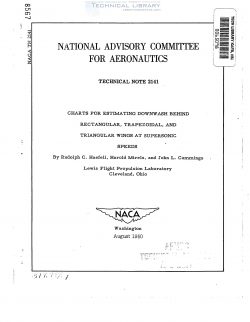naca-tn-2141
- Version
- 60 Downloads
- 2.25 MB File Size
- 1 File Count
- December 9, 2016 Create Date
- December 9, 2016 Last Updated
National Advisory Committee for Aeronautics, Technical Notes - Charts for Estimating Downwash Behind Rectangular, Trapezoidal, and Triangular Wings at Supersonic Speeds

Charts are presented for estimating the downwash behind wings
in a supersonic stream. The wing plan forms for which computations
are made include rectangular wings with reduced aspect ratios
(cotangent of Mach angle times aspect ratio) of 2, 4, 8, and 12;
trapezoidal wings with reduced aspect ratios ranging from.2 to 12.8
and taper ratios of 1/2 and 1/4; and triangular wings with reduced
aspect ratios of 8 and 12. All the wings have supersonic leading
and trailing edges.
The charts are obtained on the basis of lifting-line theory.
For each wing, charts of the dovnwash near the wing, the downwash
in the Trefftz plane, and the spanwise distribution of loading are
presented. The charts are applicable behind the wings in regions
where the effect of the rolling up of the trailing vortex sheet is
not excessive. The calculation of downyash farther downstream is
briefly discussed.
A procedure is indicated to correct for the displacement and
the distortion of the trailing vortex sheet. The downwash behind
wings with flaps is briefly considered.
Charts presented in reference 1 for the downwash behind wings
at subsonic speeds have proved of great value to the aircraft
designer. With the recent emphasis on high-speed flight, a similar
series of charts for the downwash behind wings at supersonic speeds
would be equally useful. A computational program.was therefore
undertaken at the NASA Lewis laboratory to provide such charts.
The downw-ash charts presented herein are based on the lifting-
line theory of reference 2. Downwash results obtained from the
linearized theory of_ reference 2 may differ from those encountered
in practice due to (from references 1 and 3) :
1. Displacement and distortion of the trailing vortex sheet
2. Differences between theoretical and actual spanwise distri-
bution of loading
3. Wing-body interference
4. Viscous-wake effects
A first-order correction for the displacement and the distortion
of the trailing vortex sheet, as suggested in reference 1, is
incorporated. The region of validity of this approximation is dis-
cussed on the basis of the analysis of reference 4.
| File | Action |
|---|---|
| naca-tn-2141 Charts for Estimating Downwash Behind Rectangular, Trapezoidal, and Triangular Wings at Supersonic Speeds.pdf | Download |

Comment On This Post